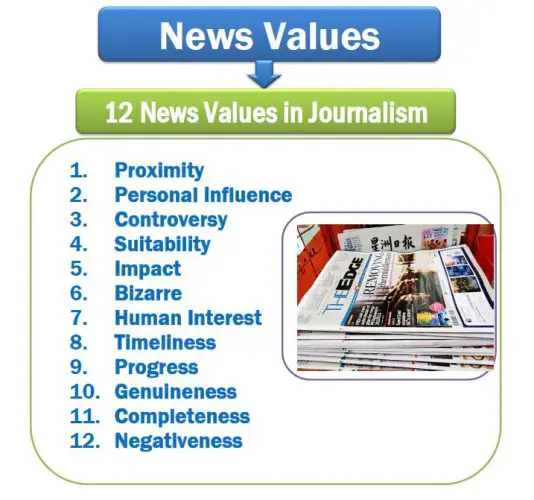This feature explains the concept of news values in journalism. It also describes the 12 types of news values in journalism with examples.
News Values in Journalism
News value in journalism refers to the significant elements of newsworthiness. Journalist focuses on maintaining news values to increase newsworthiness. The news values in journalism are components that significantly influence newsworthiness; therefore, they are also known as the elements of newsworthiness. The importance of news is a common principle determining how media outlets prioritize the news story. The components of newsworthiness set the importance of the news story.
The 12 news values in journalism are Proximity, Controversy, Personal Influence, Suitability, Impact, Bizarre, Human-Interest, Timeliness, Progress, Genuineness, Completeness, and Negativeness. These elements of newsworthiness determine whether the news is necessary for the readers. They are also called news determinants. Hence, media practitioners have long focused on these elements to increase the value of news.
However, the social and political contexts can affect news values; for example, in North Korea, media outlets cannot publish controversial or negative news. In North Korea, the news media are regulated under the authoritarian theory of the press; therefore, these media do not acknowledge negativeness as a news value or newsworthiness. Journalists are unable to publish the information that they want.
Print journalism is one of the primary forms of journalism in mass media, following broadcast and online journalism. It has different forms of journalism: art journalism, investigative journalism, sports journalism, and yellow journalism. The journalists focus on news value to collect and publish news through newspapers. The news value in journalism has become crucial in justifying the importance of the news leads and stories.
Types of News Values in Journalism
The 12 News Values in Journalism are:
- Proximity
- Personal influence
- Controversy
- Suitability
- Impact
- Bizarre
- Human Interest
- Timeliness
- Progress
- Genuineness
- Completeness
- Negativeness

1. Proximity
Proximity refers to the area around the event where the incident occurs. It also indicates the location of the news event. Proximity is one of the significant news values in journalism. The proximity or location of a news event affects its value. The closer the place is, the more interested you are in reading the information. Readers are more excited to read a news story if it occurs near them. So, proximity positively affects newsworthiness; hence, it is a significant element.
Proximity News Example
For example, “Water pollution problem in Johor Bahru.”
Another example of the news value of proximity:
“Local Charity Provides Thanksgiving Meals to Families in Need”
In the heart of our community, a local charity, ‘Hope for All,’ organized a Thanksgiving meal distribution event yesterday, bringing warmth and nourishment to families facing hardship this holiday season. Located blocks away from our neighborhood, the charity’s volunteers gathered at the community center to assemble and distribute hundreds of turkey dinners with all the trimmings to residents in need.
This story highlights the proximity news value by focusing on an event that directly impacts the local community. By reporting on initiatives like ‘Hope for All,’ which operates within proximity to the readership area, the news story resonates with the audience’s experiences and concerns, fostering a sense of connection and solidarity within the community.
2. Controversial
Controversy means a conflicting news story that adds newsworthiness. It is also known as disagreement of the news event: the more controversial the news, the more critical the report to the readers. Controversy attracts readers to the information, which adds a sense of drama to the news story. People are always eager to identify the truth behind the conflict. So, controversy is another crucial news value in journalism or an element of newsworthiness.
For example, the BJP minister says that the Taj Mahal was a Shiva temple long ago. Malaysia Airlines flight MH370: explaining media controversy.
3. Personal Influence
Personal influence refers to a person’s prominence in newsworthiness. A famous person always plays a significant role in increasing the news value. Therefore, the media covers news about well-known people, including politicians, sportspeople, and celebrities. The audience feels a close connection with their idols. For example, the followers of Lionel Messi, also a famous football player, will read any news related to Messi. The most prominent person values the news the most. The person can be an athlete, an artist, a politician, or a social worker.
For Example, Profile Feature Article: The Amazing Life of Paul McCartney.
4. Suitability
Suitability refers to the extent of public involvement in the topics. The news story is more newsworthy if more people are involved with the issue. It is also known as the much-talked-about issue in the country. The more people involved, the greater the value of the news in journalism.
For example, around 30,000 students at the University of Putra Malaysia have registered for vaccination.
Also, “Many were killed in the crash, 1 million youths gathered in Putrajaya.”
5. Impact
Impact refers to the physical influence of news writing on a large audience. The effect of news value on audience engagement is significant—the more people engage with the news, the more critical the topic. For example, price hikes have been the most relevant issue in attracting people to read any updated news related to the topic. Therefore, the News media feel interested in covering any news related to price hiking. It has a significant impact on audiences.
For example, “Inflation cooled last month, but some price hikes continue to cause pain.”
6. Bizarre News Value
Bizarre is a significant element in increasing the value of the news. Bizarre means strange; naturally, people like to read, watch, and talk about weird issues. Therefore, journalists publish strange events to attract audiences. It added value to the news and boosted circulation.
For Example, “Africa’s Real-Life Mowgli Loves to Live Amid Trees.”
7. Human-Interest
Human-interest news stories automatically attract a massive number of people. It includes the much-talked-about event and the country’s issues. International topics have also become human-interest stories due to globalization. For example, during the FIFA World Cup, people worldwide talk about Football everywhere. So, journalists carefully pick a story topic to get more viewers.
For example. “World Cup 2026 Qualifiers: Schedule, scores, dates, standings.”
8. Timeliness (Fast News)
Timeliness in journalism means providing information to the audience quickly. The sooner the news is published, the more critical it is to reach the audience. Journalists want to publish news as soon as possible to enhance the media outlet’s corporate reputation. The audience gives greater weight to the mass media outlet that first disseminates the news.
Timeliness is an occasion that enhances the value of news. People do not like to read the same news repeatedly; therefore, news outlets show interest in disseminating information as soon as possible. It is related to current and ongoing events. For example, many newspapers publish news about the Olympics as the event continues. Newspapers will not be interested in disseminating information about the Olympic Games when the event ends.
For example, in May 2021, many passengers were injured due to the LRT crash. Many news outlets cover the news to get the audience’s attention. However, people give more importance to the newspapers that publish the news quickly.
For example: “Malaysia LRT crash: Train was driven in the wrong direction, 6 critically injured.”
9. Progress
Progress news in journalism refers to the sensational updates of current events that journalists focus on to attract a larger audience. It adds massive significance to the news story to attract the audience. Progress news is always attractive to the audience for its advancement. The progress news is delivered through press conferences and seminars.
For example, the health ministry disseminates the updated number of COVID-19-affected patients through press conferences. So, it is an example of a progress news story.
10 Genuineness News Value
Genuine news means an authentic story collected from a trustworthy source. People always want to know the facts about the news. The audience determines the authenticity of the news through the genuineness of the witness and the trustworthiness of the source.
For example, according to the WHO, 192 million people have been affected by the coronavirus, and 4.13 million people have died. Most people will believe this news because the World Health Organization (WHO) disseminates it through press conferences.
11. Completeness
Complete news includes the 5Ws and 1 H news writing methods. The five Ws and one H report writing rules indicate the who, what, when, where, why, and how. A journalist should find all these questions to make the report comprehensive for the audience. People do not like incomplete news and ambiguous information. Therefore, reporters must focus on the inverted pyramid news-writing formula to produce complete news. 5W and 1H reporting strategies to make the report more attractive and more readily accepted by readers.
In conclusion, every reporter needs to follow these four key elements to make the news more engaging for the audience.
12. Negativeness
Negative news spreads faster than positive news. People discuss and share adverse events more than ordinary news. Negative news occurs for a shorter period than positive news. Netizens share this type of news excessively on social media. Therefore, negative news goes viral quickly. Online newspapers disseminate negative news, and social media is a common source of it. The easy accessibility of social media and the publishing of user-generated content significantly encouraged people to spread fake news.
For example, “Katie Price arrested on suspicion of ‘drink driving’ and taken to hospital after crash.”
Conclusion
The 12 news values in journalism are Proximity, Controversy, Personal Influence, Suitability, Impact, Bizarre, Human-Interest, Timeliness, Progress, Genuineness, Completeness, and Negativeness, which increase newsworthiness. Apart from the 12 news values, romance, crime, and technology are other elements.
